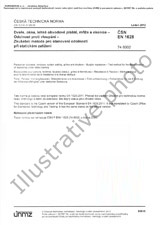We need your consent to use the individual data so that you can see information about your interests, among other things. Click "OK" to give your consent.
ČSN P CEN ISO/TS 9241-430 (833582)
Ergonomics of human-system interaction - Part 430: Recommendations for the design of non-touch gestural input for the reduction of biomechanical stress
Translate name
STANDARD published on 1.9.2023
The information about the standard:
Designation standards: ČSN P CEN ISO/TS 9241-430
Classification mark: 833582
Catalog number: 517439
Publication date standards: 1.9.2023
SKU: NS-1152389
The number of pages: 28
Approximate weight : 84 g (0.19 lbs)
Country: Czech technical standard
Category: Technical standards ČSN
The category - similar standards:
Occupational safety. Industrial hygieneErgonomicsIT terminal and other peripheral equipment
Annotation of standard text ČSN P CEN ISO/TS 9241-430 (833582):
P CEN ISO/TS 92141-430
This document provides guidance on the design, selection and optimization of non-contacting hand and arm gestures for human-computer interaction. It addresses the assessment of usability and fatigue associated with different gesture set designs and provides recommendations for approaches to evaluating the design and selection of gestures. This document also provides guidance on the documentation of the process for selecting gesture sets.
This document applies to gestures expressed by humans. It does not consider the technology for detecting gestures or the system response when interpreting a gesture. Non-contacting hand gestures can be used for input in a variety of settings, including the workplace or in public settings and when using fixed screens, mobile, virtual reality, augmented reality or mixed-mode reality devices.
Some limitations of this document are:
- - The scope is limited to non-contacting gestures and does not include other forms of inputs. For example, combining gesture with speech, gaze or head position can reduce input error, but these combinations are not considered here.
- - The scope is limited to non-contacting arm, hand and finger gestures, either unilateral (one-handed) or bilateral (two-handed).
- - The scope assumes that all technological constraints are surmountable. Therefore, there is no consideration of technological limitations with interpreting ultra-rapid gestures, gestures performed by people of different skin tones or wearing different colours or patterns of clothing.
- - The scope is limited to UI-based command-and-control human computer interaction (HCI) tasks and does not include gaming scenarios, although the traversal of in-game menus and navigation of UI elements is within scope.
- - The scope does not include HCI tasks for which an obviously more optimal input method exists. For example, speech input is superior for inputting text than gesture input.
- - The scope includes virtual reality (VR), augmented reality (AR) and mixed reality (MR) and the use of head-mounted displays (HMDs).
- - The scope does not include the discoverability of gestures but does include the learnability and memorability of gestures. It is assumed that product documentation and tutorials will adequately educate end users about which gestures are possible. Therefore, assessing gesture discoverability is not a primary goal of the recommendations in this document
Preview of the standard ČSN P CEN ISO/TS 9241-430 (833582)
We recommend:
Technical standards updating
Do you want to make sure you use only the valid technical standards?
We can offer you a solution which will provide you a monthly overview concerning the updating of standards which you use.
Would you like to know more? Look at this page.




 Cookies
Cookies
